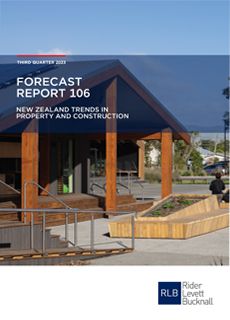According to the Rider Levett Bucknall (RLB) Forecast 106 report – New Zealand Trends in Property and Construction – construction activity is slowing with signs of reducing demand.
RLB Director Mr Grant Watkins said, “For the near term, indicators point to a weakening in the pipeline of construction work. Besides the easing in building consent issuance, sentiment indicates a reduced pipeline of construction across government, commercial and housing work.
Stats NZ Building Work Put in Place showed a slowing in construction activity, reflecting the headwinds from higher interest rates. Activity over the June 2023 quarter was broadly flat, as growth in non-residential construction offset the decline in residential construction. Construction activity was led by Auckland, which made up 40 per cent of construction activity in New Zealand on a nominal basis.
Concrete usage indicates level of construction activity
RLB’s Forecast 106 report found that concrete usage for the September 2023 quarter also provides a timelier indicator of construction activity across the regions. While there has been a decline in concrete being poured in New Zealand’s largest city over the past year, the pick-up in the September quarter points to increased construction activity in the region more recently.
In contrast, the decline in concrete usage in Wellington and Christchurch points to an easing in construction activity in these cities.
Decline in dwelling consents reflects downturn in housing market
Dwelling consent issuance provides a useful indication of near-term residential construction demand. There has been an easing in dwelling consents issued over the past year, with the weakness broad-based across the regions. The decline in dwelling consent issuance has been particularly marked in Auckland, reflecting the downturn in the region’s housing market.
While the decline in dwelling consents issued has been broadbased across the different housing types, demand for standalone houses continues to fall particularly sharply. For the year to September 2023, consents issued for standalone houses fell below that for townhouses and flats.
Mr Watkins continued, “Given the scarcity of land, we expect housing construction demand will continue to shift towards higher density housing over the coming years.”
He added, “We also expect the dampening effects of higher interest rates on construction demand will further ease capacity pressures in the construction sector. Cost pressures are also expected to ease as the rebound in net migration inflows in the wake of the reopening of international borders helps to alleviate labour shortages in the construction sector.”
“Meanwhile, the resolution of supply chain disruptions is driving a continued unwinding of building materials shortages. Overall, this combination of softer demand and increased supply should lead to a continued slowing in construction cost inflation over the coming year,” he said.
Growth of non-residential construction demand
According to Forecast 106, over the past year, increased demand for social buildings has driven growth in non-residential construction demand. Despite the slowing in retail spending as households face headwinds from higher living costs and interest rates, growth in both alterations and construction of new retail outlets was the second-highest driver in non-residential construction demand for the year to September 2023.
Increased demand for the construction of healthcare facilities also contributed to the growth in non-residential construction demand over the past year. In contrast, there has been reduced demand for the construction of office buildings and education buildings.
Building consents by region
Over the past year, growth in non-residential construction consent issuance has been concentrated in Otago, Canterbury and the Bay of Plenty. In Otago, this growth in non-residential construction demand largely reflects growth in demand for healthcare facilities.
In Canterbury, stronger construction demand for healthcare facilities and cultural buildings were the key drivers of growth in non-residential construction demand over the past year. Stronger construction demand for healthcare facilities was also the key driver of non-residential construction demand in the Bay of Plenty, with construction demand for office buildings in the region also adding support.
Building cost inflation easing
RLB expects construction cost inflation will continue to ease over the coming years, reflecting the continued softening in capacity pressures in the sector. Building sector firms report a reduction in labour shortages as the reopening of international borders allows firms to bring in workers from overseas, while construction demand is easing (albeit from high levels).
Mr Watkins concluded, “We forecast annual non-residential construction cost inflation to ease to 4 per cent in mid-2024. Beyond 2024, we expect a continued easing in capacity pressures in the construction sector will drive annual non-residential construction cost inflation to below 3 per cent over 2025 before picking up in the subsequent years as demand for construction recovers.”
FURTHER INFORMATION:



